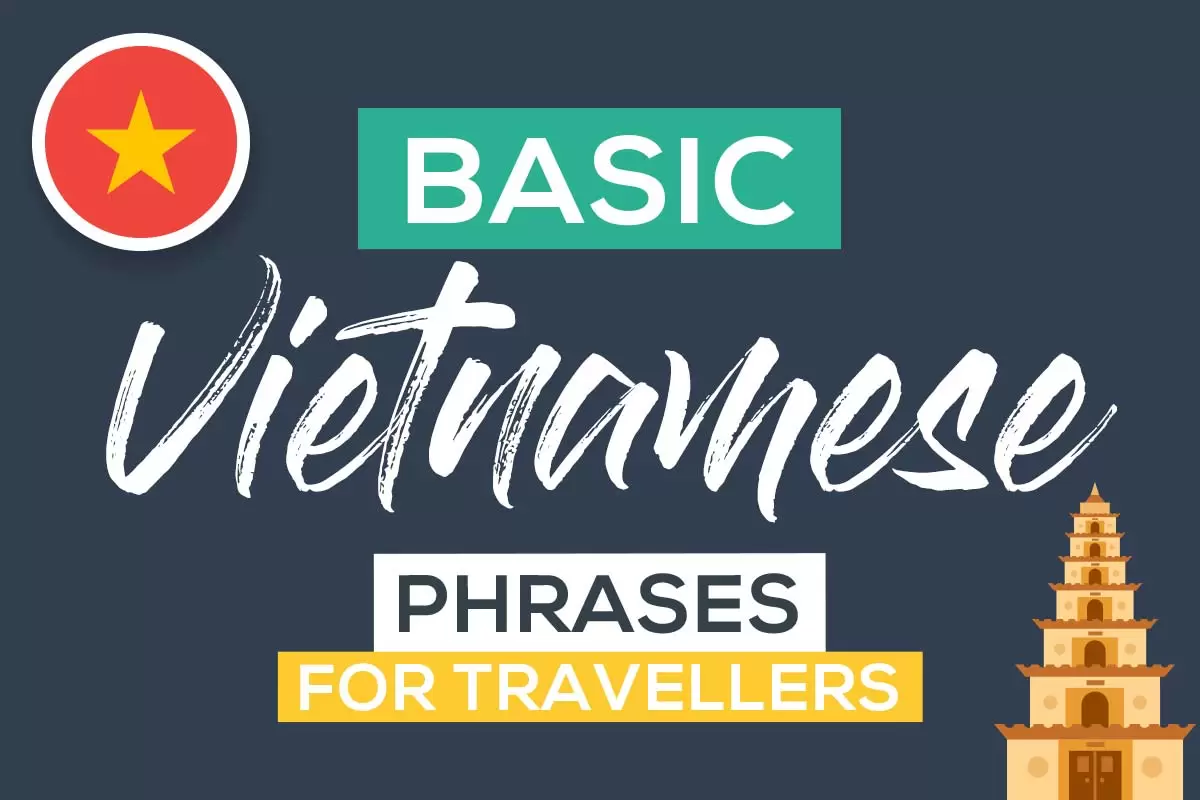Going to Vietnam? This Vietnamese phrase guide is the perfect travellers companion. Experience the best of Vietnam, make friends, and avoid being lost in translation.
Before you take that trip to Vietnam, you should definitely learn some survival Vietnamese phrases. This travel phrase guide teaches you over 60 useful phrases that will help you get around, make friends, order food, ask for directions and ensure you have an amazing time in Vietnam.
To help me create this new addition to my collection of free travel phrase guides, I asked my friend and Vietnamese speaker Trang from Travel with Trang to provide accurate Vietnamese translations and pronunciation tips. She’s even provided audio clips for each phrase to make things even easier for you.
Want to have fun whilst learning Vietnamese? Struggling to find decent Vietnamese language resources? I recommend getting uTalk. Available as a desktop site and app, uTalk is awesome for learning key words and phrases in Vietnamese, especially if you want to use it for travel purposes. It’s great for beginners getting started in a language and invaluable for intermediates looking to fill in gaps in their vocabulary and pronunciation.
What I love most about uTalk is that you can jump around their extensive library of topics and choose what you want to learn, when you want, and at your own pace. Because I believe in uTalk so much, I reached out to them and we’ve teamed up to offer you an exclusive 30% OFF reader discount across all of uTalk’s 140 languages! This offer isn’t available anywhere else! Click here to claim your exclusive 30% discount.
Let’s take a closer look at the Vietnamese language. Here’s what we’ll cover:
Table of Contents
- Where is Vietnamese spoken?
- How many people speak Vietnamese?
- Vietnamese Alphabet
- Vietnamese Pronunciation
- Vietnamese Tonal System
- Vietnamese Grammar
- Useful Vietnamese Phrases for Travellers
- Useful Vietnamese Phrases for Travellers [Infographic]
Where is Vietnamese spoken?
Not only is Vietnamese the official language of Vietnam, but it is also widely spoken in areas where the Vietnamese have immigrated, including Australia, France, the United States, South East Asia, and Western Europe. Vietnamese has also been officially recognised as a minority language in the Czech Republic.
How many people speak Vietnamese?
Vietnamese is one of the most spoken languages in the world with approximately 85 million speakers worldwide.

Rice field in Vietnam
Vietnamese Alphabet
Vietnamese uses the same alphabet as Latin languages with a few modifications which include tone and vowel markers. French missionaries changed the written language from Chinese characters in the 17th-century, but their system didn’t become widespread until the 20th-century. Because of this shift to the Roman alphabet, learning to read and write Vietnamese is much easier than most other Asian languages.
The Vietnamese alphabet has a 29-letter phonetic alphabet which includes all letters of in the English alphabet except j, f, w, and z. Vietnamese has 12 vowels and 17 consonants as shown below.
| a (a in father) | h (h in house) | q (qu in queue) |
| ă (a in hat) | i (e in she) | r (r in run) |
| â (u in but) | k (k in kick) | s (s in sing) |
| b (b in baby) | l (l in love) | t (t in tea, but softer and unaspirated) |
| c (c in can) | m (m in mother) | u (oo in good) |
| d (z in zoo) | n (n in nice) | ư (oo in boot but with unrounded lips) |
| đ (d in do) | o (o in hot) | v (v in van) |
| e (e in trend) | ô (o in hope) | x (s in sea) |
| ê (a in mate) | ơ (u in fur) | y (e in she) |
| g (g in go) | p (p in pick) |
Vietnamese Pronunciation
Vietnamese spelling is phonetic and very similar to Portuguese (which it is based on). Once you figure out how to pronounce each letter and tone, you will have a pretty good grasp of how to correctly pronounce Vietnamese words. Compared to English, Vietnamese has few exceptions to these rules.
There are three main varieties of spoken Vietnamese including Northern (used around Hanoi), which is quite different from Southern (Saigon/Ho Chi Minh City ), and Central (Hue) Vietnamese. This guide used the Northern (Hanoi) pronunciation.
Vietnamese Tonal System
If you listen closely to a Vietnamese speaker, you will notice that some words are pronounced with a high or low pitch and other sound more musical. This is because Vietnamese uses tones to make distinctions between words. Other tonal languages include Norwegian, Swedish and Thai, just to name a few. Vietnamese syllables can have six different tones, with five of them indicated by tone marks applied to the syllable’s main vowel. Tone marks can be combined with the other diacritics.
Here’s an example of the letter a’ with it’s various sounds
a – flat
á – high rising; example: đấy, like saying “day?”
à – low
ã – creaky
ả – falling, then rising
ạ – a low “a’ah”
Because tones are so important in being correctly understood, Trang and I have included audio clips for each phrase to help you with your pronunciation.
Vietnamese Grammar
One of the fascinating things about the Vietnamese is its grammar. As a whole, Vietnamese grammar is very simple in that nouns and adjectives don’t have genders and verbs aren’t conjugated. This is a welcome change for learners of European languages such as French, Italian, and Spanish where you live and die by nailing these rules.
Vietnamese has its own quirks, if you will, that I find super interesting. For example, it might sound strange but Vietnamese is spoken almost entirely in the second and third persons. So, instead of saying “I think you are very beautiful” to a girl you like, you might say, “This older male thinks you (the younger female) very beautiful”.
To Western ears, talking in the third person can sound very pretentious, but to Vietnamese ears it is totally normal.
Vietnamese has a word for “I”, (tôi) but it’s only used in formal situations such as public speaking, talking to a TV camera, or writing a book. Foreigners, naturally tend to use tôi in conversation, which to Vietnamese ears sounds unnatural but they understand why we do it and almost expect it.
In addition to this, there is a proper way to refer to yourself and others depends. This all depends on hierarchy, age, and sex. Many of these terms have literal translations that refer to family relationships, though they are used for all people on all occasions. Without going into too much detail for each, it’s important to be aware of such distinction. Options include:
- Bạn- friend, pronounced “bhang” with a heavy A
- Con – child, pronounced “ghone”
- Em – literally, younger person, generally reserved for a younger sister, younger female relative, or a younger female acquaintance. This is the equivalent of “my dear”.
- Anh – older brother
- Chị – older sister – woman older than you by up to 10-20 years
- Chú (literally, “Mister” with implications toward “uncle”)
- Cô (literally, “Miss” or “Young Mrs.” – woman older than you by 10+ years)
- Bác (unisex term, used for both Sir and Madam, – refers to a mature person, generally 40 to 60 years old)
- Ông (literally, “old gentleman”, grandfather)
- Bà (literally, “Madam” or “elderly lady”, grandmother)
Useful Vietnamese Phrases for Travellers
 Want the infographic to take with you? Scroll to the bottom of the page and save it.
Want the infographic to take with you? Scroll to the bottom of the page and save it.
P.S. If you’re reading this on your phone and can’t see the pronunciation column, turn it to landscape mode. For some reason, tables aren’t mobile friendly. Sorry!
Useful Vietnamese Phrases for Travellers [Infographic]
Like it? Pin it for later!

Sources VietnamesePod101 | Instant Vietnamese | Survival Vietnamese | Wikipedia | Lonely Planet Vietnamese Phrasebook & Dictionary
Want to know more about learning languages? Start here!
- Language learning tips: 11 Polyglots Reveal The Secrets of Their Success
- Top Language Learning Resources You Should Use
- 11 Life-Changing Reasons Why You Should Learn a Language
- 42 beautiful Inspirational Quotes for Language Learners
- Top 10 Best Ways to Learn a Language Better and Faster
Over to you!
Which of these Vietnamese phrases did you find the most useful? Are you planning a trip to Vietnam or have already been? Let me know using the comments section below or join me on social media to start a conversation.
Thanks for reading and I hope you enjoyed this post.
Like what you see? Subscribe using the form below to have all of my posts delivered directly to your email.


2 comments
Very good word lists! Useful with the correct Viet spelling and pronounciation sound files make it much easier to read and remember the ăccents used! I like the variety of words in each list and I know after studying these word lists that my knowledge of Viet will have grown significantly and thanks to the study I’ve been doing on these word lists my reading has improved and so has my pronounciation!
I’d like it if the were word lists for Romance, Nightclubs and other activities.
All together a lot of thought went into this work and I am grateful for it!
Hey Chris! Thank you so much for your lovely feedback :) I’m so glad you found it useful. Duly noted on the translations. It’s hard to know when to stop putting in phrases/words. The idea is just to get the language juices flowing for those new to the language and using it for travel.